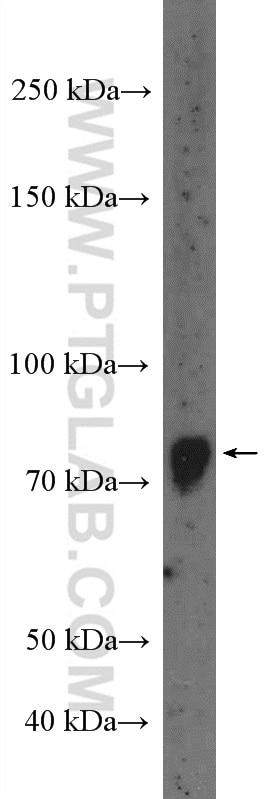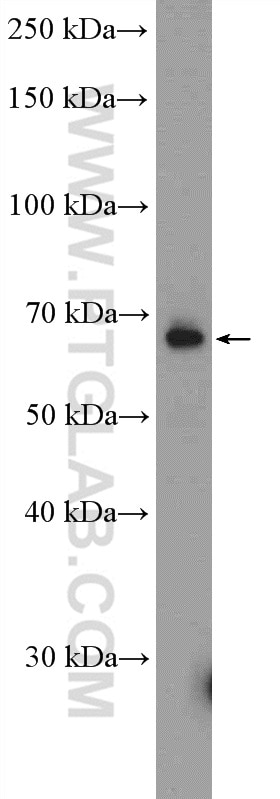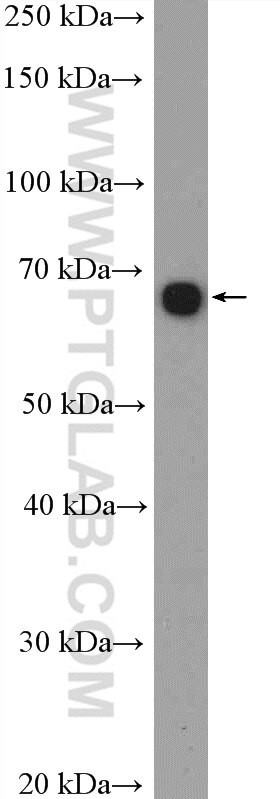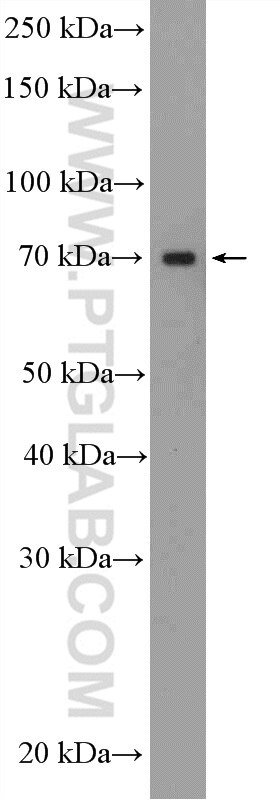Anticorps Polyclonal de lapin anti-GLIS3
GLIS3 Polyclonal Antibody for WB, ELISA
Hôte / Isotype
Lapin / IgG
Réactivité testée
Humain, rat, souris
Applications
WB, ELISA
Conjugaison
Non conjugué
N° de cat : 12678-1-AP
Synonymes
Galerie de données de validation
Applications testées
| Résultats positifs en WB | tissu rénal de souris, cellules A549, cellules BxPC-3, cellules HepG2 |
Dilution recommandée
| Application | Dilution |
|---|---|
| Western Blot (WB) | WB : 1:200-1:1000 |
| It is recommended that this reagent should be titrated in each testing system to obtain optimal results. | |
| Sample-dependent, check data in validation data gallery | |
Applications publiées
| WB | See 2 publications below |
Informations sur le produit
12678-1-AP cible GLIS3 dans les applications de WB, ELISA et montre une réactivité avec des échantillons Humain, rat, souris
| Réactivité | Humain, rat, souris |
| Réactivité citée | Humain, souris |
| Hôte / Isotype | Lapin / IgG |
| Clonalité | Polyclonal |
| Type | Anticorps |
| Immunogène | GLIS3 Protéine recombinante Ag3366 |
| Nom complet | GLIS family zinc finger 3 |
| Masse moléculaire calculée | 775 aa, 84 kDa |
| Poids moléculaire observé | 70-85 kDa |
| Numéro d’acquisition GenBank | BC033899 |
| Symbole du gène | GLIS3 |
| Identification du gène (NCBI) | 169792 |
| Conjugaison | Non conjugué |
| Forme | Liquide |
| Méthode de purification | Purification par affinité contre l'antigène |
| Tampon de stockage | PBS with 0.02% sodium azide and 50% glycerol |
| Conditions de stockage | Stocker à -20°C. Stable pendant un an après l'expédition. L'aliquotage n'est pas nécessaire pour le stockage à -20oC Les 20ul contiennent 0,1% de BSA. |
Informations générales
Zinc-finger proteins contain DNA-binding domains and have a wide variety of functions, most of which encompass some form of transcriptional activation or repression. GLIS3 (gLIS family zinc finger 3), also known as ZNF515 that localizes to the nucleus and contains five C2H2-type zinc fingers. Expressed in a variety of tissues, including kidney, brain, liver, lung, ovary, pancreas, thymus and skeletal muscle, GLIS3 functions as both an activator and a suppressor of transcription, specifically binding the consensus sequence 5'-GACCACCCAC-3' through its C2H2-type zinc fingers. Defects in the gene encoding GLIS3 are a cause of NDH syndrome; a neonatal diabetes that is characterized by congenital hypothyroidism, congenital glaucoma, hepatic fibrosis and polycystic kidneys. There are various isoform of GLIS3 and molecular weight of one isoform is 70 kDa.
Protocole
| Product Specific Protocols | |
|---|---|
| WB protocol for GLIS3 antibody 12678-1-AP | Download protocol |
| Standard Protocols | |
|---|---|
| Click here to view our Standard Protocols |
Publications
| Species | Application | Title |
|---|---|---|
Physiol Genomics Polycystin-2-dependent transcriptome reveals early response of autosomal dominant polycystic kidney disease | ||
Cell Rep Class I HDAC inhibitors enhance antitumor efficacy and persistence of CAR-T cells by activation of the Wnt pathway |





